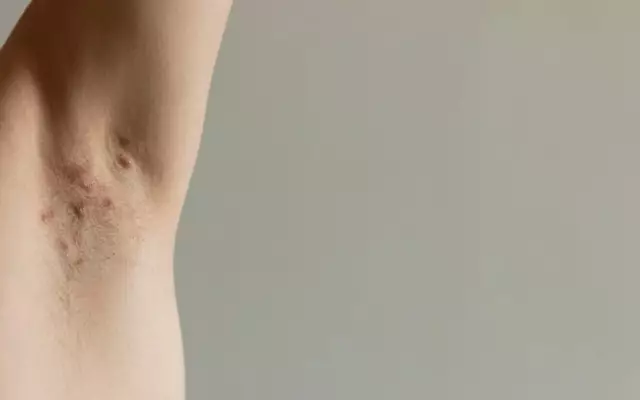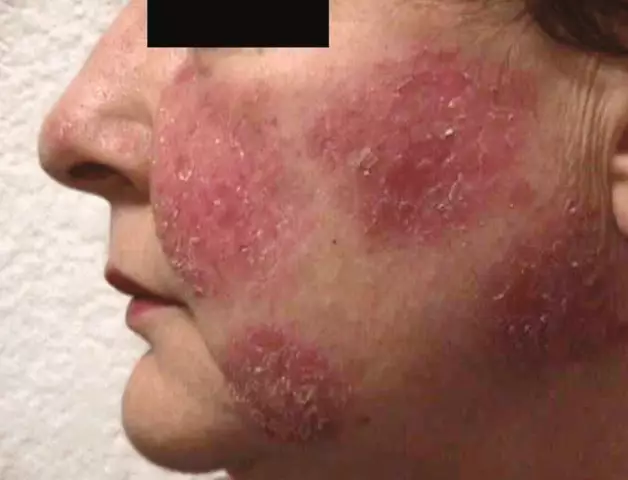- Author Rachel Wainwright [email protected].
- Public 2023-12-15 07:39.
- Last modified 2025-11-02 20:14.
Erysipelas
Brief description of the disease

Erysipelas is an infectious disease caused by hemolytic streptococci. Inflammation and deformities affect a clearly limited area of the skin, accompanied by fever and intoxication of the body. Since the activity of group A streptococci is considered the main reason why a person has erysipelas, treatment is based on taking penicillins and other antibiotics.
As a rule, the disease manifests itself after damage to the skin, but in some cases, erysipelas occurs without violating the integrity of the skin, after infection from people who are sources of pyogenic microbes enter the body. Their pathogenic effect is characterized by hyperemia, serous inflammation, infiltration of the affected areas and edema. In the absence of adequate treatment, erysipelas on the leg or other parts of the body leads to the formation of abscesses and necrosis of skin tissue. In addition, the streptococcus virus can spread throughout the body through the blood vessels and cause secondary purulent complications.
By the nature of the inflammatory process, three forms of the disease are distinguished:
- erythematous - redness and swelling of the skin;
- hemorrhagic - bleeding of blood vessels due to the phenomenon of permeability;
- bullous - the appearance of blisters on damaged areas. These bubbles are quite large and filled with serous exudate.
Erysipelas - symptoms of the disease
The incubation period lasts several days, after which local and clinical symptoms appear sharply:
- chills, general weakness;
- headache;
- nausea, vomiting, tachycardia;
- increased body temperature;
- muscle pain;
- hyperemia;
- swelling of the damaged area of the skin.
In some cases, erysipelas disease leads to delirious conditions, convulsions and meningism. Also, cases have been recorded when viruses infect not only the skin, but also regional lymph nodes. Most often, erysipelas appears on the leg, arms, trunk and face, less often on the mucous membranes.
Depending on what form the erysipelas takes, the symptoms of the disease may vary. Erythematous erysipelas is characterized by the appearance of erythema, edema, and painful sensations. The edges of the erethyma have an irregular, broken configuration, and it itself is painted in a bright pink color, clearly limited to a certain area of the skin and is accompanied by peeling.
The bullous form is similar to the erythematous one, but is characterized by the detachment of the epidermis and the formation of blisters of various sizes filled with serous contents. After some time, they burst or transform into trophic ulcers.
The hemorrhagic form proceeds against the background of the symptoms already described above and is accompanied by numerous hemorrhages in the affected areas. In rare cases, people develop bullous-hemorrhagic erysipelas - a disease that leads to the formation of blisters, like the usual bullous form, but they are filled not with serous, but with hemorrhagic exudate.
With the eramatic form, fever and intoxication last up to 5 days, with other forms - up to 10-15 days or more. Erysipelas, the treatment of which was carried out irrationally or was accompanied by fungal and purulent lesions, may recur 2 years after the previous disease. It is also caused by provoking factors - hypothermia of the body, harmful working conditions, past chronic diseases or damage to the lymph nodes. The recurrent form is most often manifested in young people and the elderly.
In the absence of adequate treatment, erysipelas disease leads to phlegmons, abscesses, necrosis of skin areas, infectious toxic shock and encephalopathy. The elderly may develop secondary pneumonia and sepsis.
Erysipelas - disease treatment

The method of treatment depends on the degree of intoxication of the body, associated complications and the frequency of the disease. The most effective is etiotropic therapy - taking tetracycline, penicillin, olettrin, erythromycin and other antibacterial drugs. It is desirable to carry out two courses of therapy with a change of drugs (after 7-10 days, lasting at least 10 days). With a recurrent form, corticosteroids are indicated (daily dose - 30 mg).
In the case of persistent infiltration, erysipelas on the leg and other parts of the body is treated with anti-inflammatory drugs - rheopirin, butadiene and chlotazole. Autohemotherapy is also effective. Acute foci of inflammation are affected by UHF and UFO.
With a bullous form, local treatment is permissible - applying dressings with a solution of furacilin or rivanol. For greater effectiveness, Shostakovsky's balm and dressings with ektericin are used simultaneously with them. The use of such funds should alternate with physiotherapy procedures.
Erysipelas, which is treated with proper quality and adherence to all procedures provided for in such cases, has a favorable prognosis. Otherwise, it recurs and leads to various complications (phlegmon, abscesses, damage to regional lymph nodes).
YouTube video related to the article:
The information is generalized and provided for informational purposes only. At the first sign of illness, see your doctor. Self-medication is hazardous to health!






